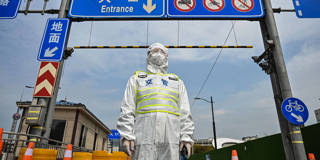China's full-scale lockdown of Shanghai, the country's largest urban economy, will have far-reaching economic and social costs. More than just a public-health measure, the move should be interpreted as a reassertion of centralized control and a partial reversal of the devolution of power that took root after 1978.
CHICAGO – After signaling that it was moving to a more nuanced COVID-19 policy, Shanghai – a city of 26 million – was pressured by the central government to lock down in late March, and has only just started to ease restrictions after almost one month. The official reason for this drastic policy shift is that citywide testing had revealed high infection rates. Yet one is left wondering why the authorities didn’t opt for a less costly alternative to a complete lockdown.
After all, Omicron, which now accounts for almost all new cases globally, has only mild effects on vaccinated people. And while China’s elderly population does have a surprisingly low vaccination rate (around 60%), immunizing this cohort is well within the country’s messaging and mobilization capabilities.
Moreover, complete lockdowns have high economic costs. Economists estimate that Shanghai’s closure could reduce overall Chinese GDP by 4% this year. And Chinese authorities have introduced additional economic uncertainty by shifting suddenly from a four-day lockdown to an indefinite one. Shanghai officials did not have time to set up the infrastructure needed to sustain a prolonged lockdown, and residents were unable to stock up on enough food before being confined to their homes. The fact that the city has recorded only 17 deaths (as of April 20, 2022) has added to the public’s anger and frustration.

CHICAGO – After signaling that it was moving to a more nuanced COVID-19 policy, Shanghai – a city of 26 million – was pressured by the central government to lock down in late March, and has only just started to ease restrictions after almost one month. The official reason for this drastic policy shift is that citywide testing had revealed high infection rates. Yet one is left wondering why the authorities didn’t opt for a less costly alternative to a complete lockdown.
After all, Omicron, which now accounts for almost all new cases globally, has only mild effects on vaccinated people. And while China’s elderly population does have a surprisingly low vaccination rate (around 60%), immunizing this cohort is well within the country’s messaging and mobilization capabilities.
Moreover, complete lockdowns have high economic costs. Economists estimate that Shanghai’s closure could reduce overall Chinese GDP by 4% this year. And Chinese authorities have introduced additional economic uncertainty by shifting suddenly from a four-day lockdown to an indefinite one. Shanghai officials did not have time to set up the infrastructure needed to sustain a prolonged lockdown, and residents were unable to stock up on enough food before being confined to their homes. The fact that the city has recorded only 17 deaths (as of April 20, 2022) has added to the public’s anger and frustration.